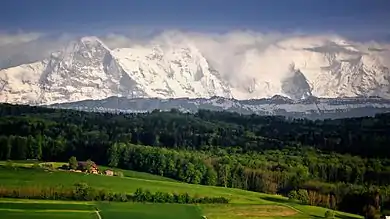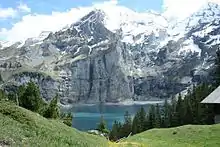Bernese Alps
The Bernese Alps (German: Berner Alpen, French: Alpes bernoises, Italian: Alpi bernesi) are a mountain range of the Alps, located in western Switzerland. Although the name suggests that they are located in the Berner Oberland region of the canton of Bern, portions of the Bernese Alps are in the adjacent cantons of Valais, Fribourg and Vaud, the latter being usually named Fribourg Alps and Vaud Alps respectively. The highest mountain in the range, the Finsteraarhorn, is also the highest point in the canton of Bern.
| Bernese Alps | |
|---|---|
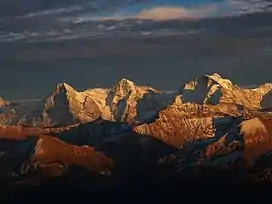 | |
| Highest point | |
| Peak | Finsteraarhorn |
| Elevation | 4,274 m (14,022 ft) |
| Coordinates | 46°32′19″N 8°07′38″E |
| Naming | |
| Native name | |
| Geography | |
 Map of Bernese Alps and their location in Switzerland (red)
| |
| Country | Switzerland |
| Cantons | Bern, Vaud, Fribourg and Valais |
| Range coordinates | 46°25′N 7°45′E |
| Parent range | Western Alps |
| Borders on | Chablais Alps, Pennine Alps, Lepontine Alps, Uri Alps and Emmental Alps |
| Topo map | Swiss Federal Office of Topography swisstopo |
The Rhône valley separates them from the Chablais Alps in the west and from the Pennine Alps in the south; the upper Rhône valley separates them from the Lepontine Alps to the southeast; the Grimsel Pass and the Aare valley separates them from the Uri Alps in the east, and from the Emmental Alps in the north; their northwestern edge is not well defined, describing a line roughly from Lake Geneva to Lake Thun. The Bernese Alps are drained by the river Aare and its tributary the Saane in the north, the Rhône in the south, and the Reuss in the east.
The Bernese Alps are amongst the three highest major subranges of the Alps, together with the Pennine Alps and the Mont Blanc massif.[1]
Geography
One of the most prominent Alpine ranges, the Bernese Alps extend from the gorge of Saint-Maurice, through which the Rhône finds its way to Lake Geneva, to the Grimsel Pass or, depending on the definition, to the river Reuss (thus including the Uri Alps). The principal ridge, a chain that runs 100 kilometres (62 mi) from west (Dent de Morcles) to east (Sidelhorn), whose highest peak is the Finsteraarhorn, forms the watershed between the cantons of Bern and Valais. Except for the westernmost part, it is also the watershed between the Rhine (North Sea) and the Rhône (Mediterranean Sea). This chain is not centered inside the range but lies close (10 to 15 km) to the Rhône on the south. This makes a large difference between the south, where the lateral short valleys descend abruptly into the deep trench forming the valley of the Rhône and the north, where the Bernese Alps extends through a great part of the canton of Bern (Bernese Oberland), throwing out branches to the west into the adjoining cantons of Vaud and Fribourg. There the mountains progressively become lower and disappear into the hilly Swiss Plateau.[2] The Bernese Alps have a large influence on the climate of Switzerland: while their north side is very exposed to weather, their south side is protected from it. As a consequence, agriculture consists essentially of dairy farming and cattle breeding on the northern foothills, while on the sunnier southern foothills (Rhone Valley) it also consists of vineyards.
Gemmi Pass is the most central of the major passes through the main chain. It also marks the separation between two distinct sections of the Bernese Alps: the chain west of Gemmi Pass, consisting mainly of foothills with a few large glacier-covered mountains (notably Dent de Morcles, Grand Muveran, Diablerets, Wildhorn and Wildstrubel) around 3,000 metres (9,800 ft), and the chain east of Gemmi Pass, consisting mainly of summits around 4,000 metres (13,000 ft) on several subranges, with large valley glaciers between them. The latter section, contrary to the former, has very few foothills and is the most glaciated part of the Alps.[3]
A characteristic in the orography of the Bernese Alps is, that whereas the western portion of that chain consists of a single series of summits with comparatively short projecting buttresses, the higher group presents a series of longitudinal ridges parallel to the axis of the main chain, and separated from each other by deep valleys that form the channels of great glaciers. Thus the Tschingel Glacier and the Kander Glacier, separate the portion of the main range lying between the Gemmi Pass and the Mittaghorn from the equally high parallel range of the Doldenhorn and Blümlisalp on its northern side. To the south, the same portion of the main range is divided from the still higher parallel range whose summits are the Aletschhorn and the Bietschhorn by the Lötschental and the Lötschenlücke. To this again succeeds the deep trench through which the lower part of the Aletsch Glacier flows down to the Rhône, enclosed by the minor ridge that culminates at the Eggishorn.[2]
It is in the central and eastern portions of the range only that crystalline rocks make their appearance; the western part is composed almost exclusively of sedimentary deposits, and the secondary ridges extending through Bern and the adjoining cantons are formed of jurassic, cretaceous, or eocene strata.[2]
Exploration
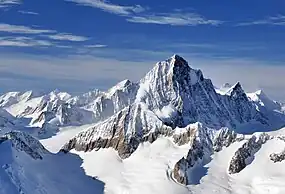
The beauty of the scenery and the facilities offered to travellers by the general extension of mountain railways make the northern side of the range, the Bernese Oberland, one of the portions of the Alps most visited by tourists. Since strangers first began to visit the Alps, the names of Grindelwald, Lauterbrunnen, and Interlaken have become famous. But unlike many other Alpine regions, which have been left to be explored by strangers, this region has been long visited by Swiss travellers and men of science. Among them were the brother Meyer of Aarau and Franz Joseph Hugi. They have explored most of the mountain ranges not very difficult to access, and have climbed most of the higher summits. In 1841, Louis Agassiz, with several scientific friends, established a temporary station on the Unteraar Glacier, and, along with scientific observations on the glaciers, started a series of expeditions. Several mountains in the area are named after Agassiz and the other explorers. The works of Desor and Gottlieb Studer have been followed by several other publications that bear testimony to Swiss mountaineering activity. Notwithstanding the activity of their predecessors, the members of the English Alpine Club have found scope for further exploits, amongst which may be reckoned the first ascents of the Aletschhorn and the Schreckhorn, and the still more arduous enterprise of crossing the range bypasses, such as the Jungfraujoch and Eigerjoch, which are considered among the most difficult in the Alps.[2]
Jungfrau-Aletsch area
.jpg.webp)
The Jungfrau-Aletsch area is located in the eastern Bernese Alps in the most glaciated region of the Alps. It was inscribed as a UNESCO World Heritage Site (Swiss Alps Jungfrau-Aletsch) in 2001 and further expanded in 2007. Its name comes from the Aletsch Glacier and the two summits of the Jungfrau and Bietschhorn, which constitute some of the most impressive features of the site. The actual site (after the extension) includes other large glacier valleys such as the Fiescher Glacier and the Aar Glaciers.
List of peaks
The chief peaks of the Bernese Alps are:
| Name | Elevation |
|---|---|
| Finsteraarhorn | 4,274 metres (14,022 ft) |
| Aletschhorn | 4,182 metres (13,720 ft) |
| Jungfrau | 4,166 metres (13,668 ft) |
| Mönch | 4,105 metres (13,468 ft) |
| Schreckhorn | 4,080 metres (13,386 ft) |
| Grosses Fiescherhorn | 4,049 metres (13,284 ft) |
| Grünhorn | 4,043 metres (13,264 ft) |
| Lauteraarhorn | 4,042 metres (13,261 ft) |
| Hinteres Fiescherhorn | 4,025 metres (13,205 ft) |
| Gletscherhorn | 3,983 metres (13,068 ft) |
| Rottalhorn | 3,969 metres (13,022 ft) |
| Eiger | 3,967 metres (13,015 ft) |
| Ebnefluh | 3,962 metres (12,999 ft) |
| Agassizhorn | 3,946 metres (12,946 ft) |
| Bietschhorn | 3,934 metres (12,907 ft) |
| Trugberg | 3,933 metres (12,904 ft) |
| Klein Grünhorn | 3,913 metres (12,838 ft) |
| Gross Wannenhorn | 3,905 metres (12,812 ft) |
| Kleines Fiescherhorn | 3,895 metres (12,779 ft) |
| Mittaghorn | 3,892 metres (12,769 ft) |
| Fiescher Gabelhorn | 3,876 metres (12,717 ft) |
| Schönbühlhorn | 3,854 metres (12,644 ft) |
| Nesthorn | 3,820 metres (12,533 ft) |
| Dreieckhorn | 3,811 metres (12,503 ft) |
| Schinhorn | 3,797 metres (12,457 ft) |
| Breithorn (Blatten) | 3,785 metres (12,418 ft) |
| Breithorn (Lauterbrunnen) | 3,779 metres (12,398 ft) |
| Grosshorn | 3,754 metres (12,316 ft) |
| Sattelhorn | 3,745 metres (12,287 ft) |
| Kranzberg | 3,742 metres (12,277 ft) |
| Geisshorn | 3,740 metres (12,270 ft) |
| Klein Lauteraarhorn | 3,737 metres (12,260 ft) |
| Wetterhorn | 3,708 metres (12,165 ft) |
| Mittelhorn | 3,704 metres (12,152 ft) |
| Rotstock | 3,699 metres (12,136 ft) |
| Balmhorn | 3,698 metres (12,133 ft) |
| Silberhorn | 3,695 metres (12,123 ft) |
| Rosenhorn | 3,689 metres (12,103 ft) |
| Blüemlisalphorn | 3,671 metres (12,044 ft) |
| Bärglistock | 3,656 metres (11,995 ft) |
| Breitlauihorn | 3,655 metres (11,991 ft) |
| Doldenhorn | 3,647 metres (11,965 ft) |
| Hugihorn | 3,647 metres (11,965 ft) |
| Altels | 3,636 metres (11,929 ft) |
| Gross Fusshorn | 3,627 metres (11,900 ft) |
| Tschingelhorn | 3,562 metres (11,686 ft) |
| Lonzahörner | 3,560 metres (11,680 ft) |
| Unterbächhorn | 3,554 metres (11,660 ft) |
| Finsteraarrothorn | 3,530 metres (11,581 ft) |
| Galmihorn | 3,505 metres (11,499 ft) |
| Wysshorn | 3,546 metres (11,634 ft) |
| Kleines Schreckhorn | 3,494 metres (11,463 ft) |
| Nasse Strahlegg | 3,485 metres (11,434 ft) |
| Lauteraar Rothörner | 3,478 metres (11,411 ft) |
| Wasenhorn | 3,447 metres (11,309 ft) |
| Gspaltenhorn | 3,442 metres (11,293 ft) |
| Ewigschneehorn | 3,331 metres (10,928 ft) |
| Olmenhorn | 3,314 metres (10,873 ft) |
| Hienderstock | 3,307 metres (10,850 ft) |
| Wilerhorn | 3,307 metres (10,850 ft) |
| Tschingelspitz | 3,304 metres (10,840 ft) |
| Hockenhorn | 3,293 metres (10,804 ft) |
| Ritzlihorn | 3,282 metres (10,768 ft) |
| Hogleifa | 3,278 metres (10,755 ft) |
| Wildhorn | 3,248 metres (10,656 ft) |
| Bächlistock | 3,247 metres (10,653 ft) |
| Birghorn | 3,243 metres (10,640 ft) |
| Wildstrubel | 3,243 metres (10,640 ft) |
| Hohstock | 3,226 metres (10,584 ft) |
| Stockhorn | 3,212 metres (10,538 ft) |
| Diablerets | 3,210 metres (10,531 ft) |
| Sackhorn | 3,204 metres (10,512 ft) |
| Petersgrat | 3,202 metres (10,505 ft) |
| Strahlhorn (Baltschieder) | 3,200 metres (10,499 ft) |
| Wellhorn | 3,196 metres (10,486 ft) |
| Firehorn | 3,182 metres (10,440 ft) |
| Steinlauihorn | 3,161 metres (10,371 ft) |
| Wannihorn | 3,115 metres (10,220 ft) |
| Brandlammhorn | 3,108 metres (10,197 ft) |
| Mettenberg | 3,107 metres (10,194 ft) |
| Schwarzhorn | 3,105 metres (10,187 ft) |
| Löffelhorn | 3,098 metres (10,164 ft) |
| Tieregghorn | 3,075 metres (10,089 ft) |
| Geltenhorn | 3,065 metres (10,056 ft) |
| Grand Muveran | 3,061 metres (10,043 ft) |
| Mutthorn | 3,053 metres (10,016 ft) |
| Arpelistock | 3,035 metres (9,957 ft) |
| Sparrhorn | 3,026 metres (9,928 ft) |
| Torrenthorn | 3,003 metres (9,852 ft) |
| Wiwannihorn | 3,001 metres (9,846 ft) |
| Brünberg | 2,982 metres (9,783 ft) |
| Schilthorn | 2,973 metres (9,754 ft) |
| Dent de Morcles | 2,969 metres (9,741 ft) |
| Gärsthorn | 2,964 metres (9,724 ft) |
| Eggishorn | 2,934 metres (9,626 ft) |
| Schwarzhorn | 2,930 metres (9,613 ft) |
| Ritzihorn | 2,891 metres (9,485 ft) |
| Wildgärst | 2,891 metres (9,485 ft) |
| Gross Sidelhorn | 2,881 metres (9,452 ft) |
| Alplistock | 2,878 metres (9,442 ft) |
| Risihorn | 2,876 metres (9,436 ft) |
| Bettmerhorn | 2,872 metres (9,423 ft) |
| Gallauistöck | 2,869 metres (9,413 ft) |
| Gstellihorn | 2,855 metres (9,367 ft) |
| Innerer Fisistock | 2,787 metres (9,144 ft) |
| Grosses Engelhorn | 2,782 metres (9,127 ft) |
| Chistehorn | 2,785 metres (9,137 ft) |
| Niwen | 2,769 metres (9,085 ft) |
| Albristhorn | 2,764 metres (9,068 ft) |
| Bietenhorn | 2,756 metres (9,042 ft) |
| Ärmighorn | 2,742 metres (8,996 ft) |
| Tschingellochtighorn | 2,735 metres (8,973 ft) |
| Klein Wellhorn | 2,701 metres (8,862 ft) |
| Mittaghorn | 2,686 metres (8,812 ft) |
| Birg | 2,684 metres (8,806 ft) |
| Faulhorn | 2,683 metres (8,802 ft) |
| Schwarzmönch | 2,649 metres (8,691 ft) |
| Mont à Cavouère | 2,612 metres (8,570 ft) |
| Schluchhorn | 2,579 metres (8,461 ft) |
| Bunderspitz | 2,546 metres (8,353 ft) |
| Sulegg | 2,412 metres (7,913 ft) |
| Niesen | 2,366 metres (7,762 ft) |
| Pic Chaussy | 2,351 metres (7,713 ft) |
| Tête du Portail | 2,335 metres (7,661 ft) |
| Rauflihorn | 2,323 metres (7,621 ft) |
| Gebidum | 2,317 metres (7,602 ft) |
| Wiriehorn | 2,304 metres (7,559 ft) |
| Furggenspitz | 2,297 metres (7,536 ft) |
| Pointe des Savolaires | 2,294 metres (7,526 ft) |
| Oltschiburg | 2,234 metres (7,329 ft) |
| Riederhorn | 2,230 metres (7,316 ft) |
| Vanil Carré | 2,197 metres (7,208 ft) |
| Regenboldshorn | 2,193 metres (7,195 ft) |
| Hochmatt | 2,152 metres (7,060 ft) |
| Rüdigenspitze | 2,124 metres (6,969 ft) |
| Le Chamossaire | 2,116 metres (6,942 ft) |
| Rocher du Midi | 2,097 metres (6,880 ft) |
| Vanil d'Arpille | 2,085 metres (6,841 ft) |
| Dent de Combette | 2,082 metres (6,831 ft) |
| Hohmad | 2,076 metres (6,811 ft) |
| Hohmädli | 2,021 metres (6,631 ft) |
| Wätterlatte | 2,007 metres (6,585 ft) |
| Vanil des Cours | 1,562 metres (5,125 ft) |
Glaciers
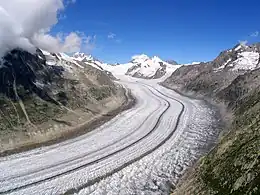
Main glaciers:
- Aletsch Glacier
- Fiescher Glacier
- Unteraar Glacier
- Lower Grindelwald Glacier
- Oberaletsch Glacier
- Mittelaletsch Glacier
- Gauli Glacier
- Lang Glacier
- Upper Grindelwald Glacier
- Kander Glacier
- Tschingel Glacier
- Rosenlaui Glacier
- Plaine Morte Glacier
- Wildstrubel Glacier
- Tsanfleuron Glacier
- Diablerets Glacier
List of mountains lakes
List of passes

The chief passes of the Bernese Alps are:
| Mountain pass | Location | Type | Elevation |
|---|---|---|---|
| Lauitor | Lauterbrunnen to the Eggishorn | Snow | 3,700 metres (12,139 ft) |
| Mönchjoch | Grindelwald to the Eggishorn | Snow | 3,560 metres (11,680 ft) |
| Jungfraujoch | Wengernalp to the Eggishorn | Snow | 3,470 metres (11,385 ft) |
| Strahlegg | Grindelwald to the Grimsel Pass | Snow | 3,351 metres (10,994 ft) |
| Grünhornlücke | Great Aletsch Glacier to the Fiescher Glacier | Snow | 3,305 metres (10,843 ft) |
| Oberaarjoch | Grimsel to the Eggishorn | Snow | 3,233 metres (10,607 ft) |
| Gauli | Grimsel to Meiringen | Snow | 3,206 metres (10,518 ft) |
| Petersgrat | Lauterbrunnen to the Lötschental | Snow | 3,205 metres (10,515 ft) |
| Lötschenlücke | Lötschental to the Eggishorn | Snow | 3,204 metres (10,512 ft) |
| Lauteraarsattel | Grindelwald to the Grimsel | Snow | 3,156 metres (10,354 ft) |
| Beichgrat | Lötschental to the Belalp | Snow | 3,136 metres (10,289 ft) |
| Lammernjoch | Lenk to the Gemmi | Snow | 3,132 metres (10,276 ft) |
| Gamchilucke | Kiental to Lauterbrunnen | Snow | 2,833 metres (9,295 ft) |
| Tschiugel | Lauterbrunnen to Kandersteg | Snow | 2,824 metres (9,265 ft) |
| Hohtürli | Kandersteg to the Kiental | Footpath | 2,707 metres (8,881 ft) |
| Lötschen | Kandersteg to the Lötschental | Snow | 2,695 metres (8,842 ft) |
| Sefinenfurgge | Lauterbrunnen to the Kiental | Footpath | 2,616 metres (8,583 ft) |
| Rawil | Sion to Lenk im Simmental | Bridle path | 2,415 metres (7,923 ft) |
| Gemmi | Kandersteg to Leukerbad | Bridle path | 2,329 metres (7,641 ft) |
| Sanetsch | Sion to Saanen | Bridle path | 2,234 metres (7,329 ft) |
| Grimsel | Meiringen to the Rhône Glacier | Road | 2,164 metres (7,100 ft) |
| Kleine Scheidegg | Grindelwald to Lauterbrunnen | Path, railway | 2,064 metres (6,772 ft) |
| Cheville | Sion to Bex | Bridle path | 2,049 metres (6,722 ft) |
| Grosse Scheidegg | Grindelwald to Meiringen | road (restricted to buses) | 1,967 metres (6,453 ft) |
See also
- Bernese Alps in the wide sense
- Swiss Alps
- The Alps (documentary film)
References
- Natural Wonders of the World. Dorling Kindersley Limited. 2017. p. 138. ISBN 9780241428436.
The Alps contain many subranges, some of which are mapped below. The loftiest are the Pennine Alps, which contain 13 of the highest 20 alpine peaks; the Bernese Alps contain four; and the Mont Blanc Massif in the Graian Alps has three.
- John Ball, The Alpine guide, Central Alps, 1866, London
- Jungfrau-Aletsch-Bietschhorn World Heritage Site
